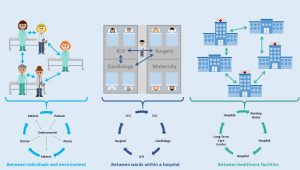WHAT IS THE SPHINx PROJECT ?
« Spread of Pathogens on Healthcare Institutions Networks » (SPHINx): a modelling study
The way human populations are structured within and outside hospitals, the transfers of patients between wards and between hospitals, as well as the drug exposure in different settings, are all scales intrinsically interacting with the biological scale of pathogen transmission. Most importantly, all these scales are bound to have interrelated impacts on the intervention strategies aiming at controlling HAI spread. Mathematical models, developed jointly with epidemiological investigations, are a powerful tool to better understand the mechanisms of HAI spread in healthcare settings. However, previously published modelling studies were typically limited to describing HAI spread at a single scale, independently of the others. This scale separation challenges our ability to get a global understanding of this phenomenon. In addition, each scale is characterized by network contacts – contacts between individuals due to proximity, contacts between healthcare institutions due to transfers of patients, contacts between patches of populations due to mobility and community/hospital interactions, which are seldom taken into account in models.
Potential routes of HAI spread
There are several ways in which infections can spread within healthcare settings,
through various routes of contact with colonised or infected individuals or with the hospital environment. The processes operating at those different scales may have opposite effects on HAI dynamics which make HAI spread prediction and control strategies assessment difficult when considering only one scale.
However, faced with the continued spread of HAI, the implementation of these strategies needs to be optimized and new control strategies must be considered and evaluated. Mathematical modelling and computer simulations are powerful tools which can help public-health practitioners examine possible courses of dissemination of HAI and assess the efficacy of control strategies. Whence the challenge of the sphinx project is to propose a global approche multi-scale.

Main objective of the SPHINx project

Strategies:
- To build one model for each scale to understand how HAI can emerge, be selected and spread within and between healthcare facilities.
- To integrate these models in a multi-scale model to reproduce potential interferences between the different scales.
- To use the developed multi-scale framework to assess and compare the potential impact of various control strategies on HAI spread and incidence, and assess their cost-effectiveness from healthcare facility, payer and societal perspectives
In this context, the innovative multi-scale modeling framework that we propose to develop will bring two types of benefits. First, it will improve our understanding of the role of the distinct scales on the spread of HAIs. Second, it will lead to more realistic estimations of the global impact of control measures, providing physicians and public health decision makers with informed guidelines to design efficient integrated infection control strategies at a local, regional and national level.
Methodological approch:
The proposed methodological approach combines mathematical modeling, Big Data analysis, epidemiology and health economics and is divided into 5 tasks:
Task1: Within hospitals: Model realistic contact patterns and between-ward patient transfers
Task5: Assess the epidemic vulnerability of the hospital system at different scales
Data sources :
Using both published data and original data including:
- Data on patient transfers between healthcare facilities and the community at the French national level,
- A detailed dataset on inter-individual contacts,
- Microbial carriage status of patients and healthcare workers
- Antibiotic exposure in a single hospital over a 4-month period.

The SPHINx project is funded through the French Research Agency (ANR).
